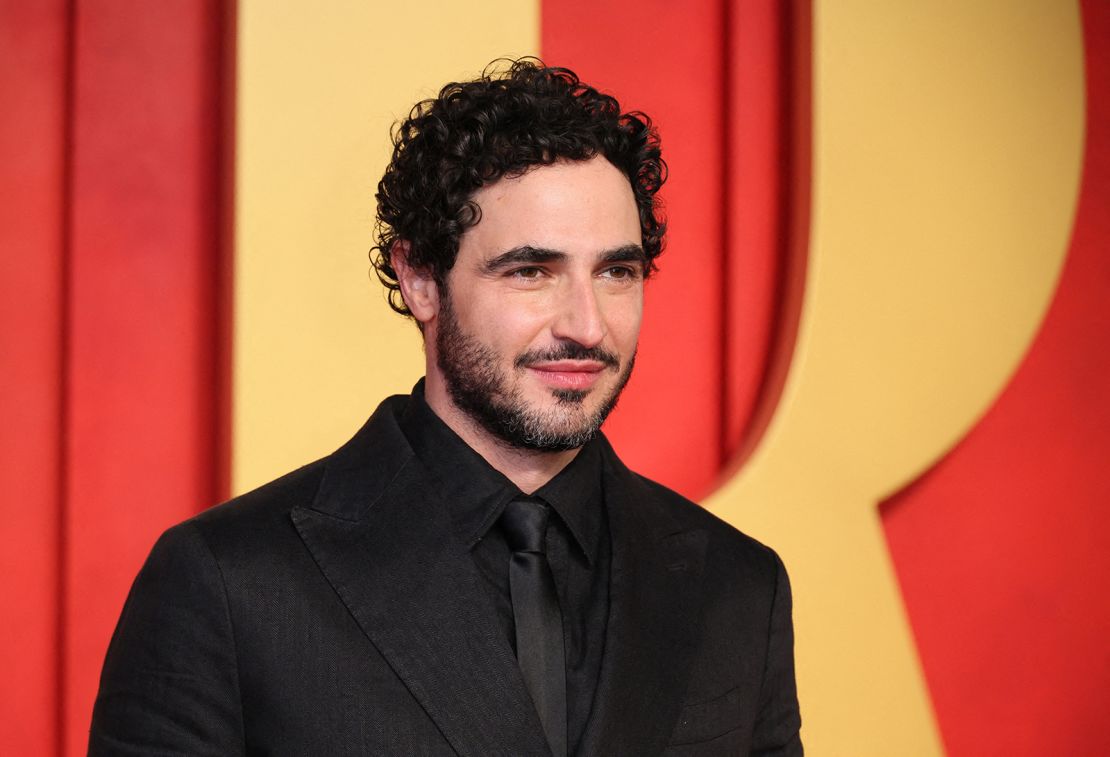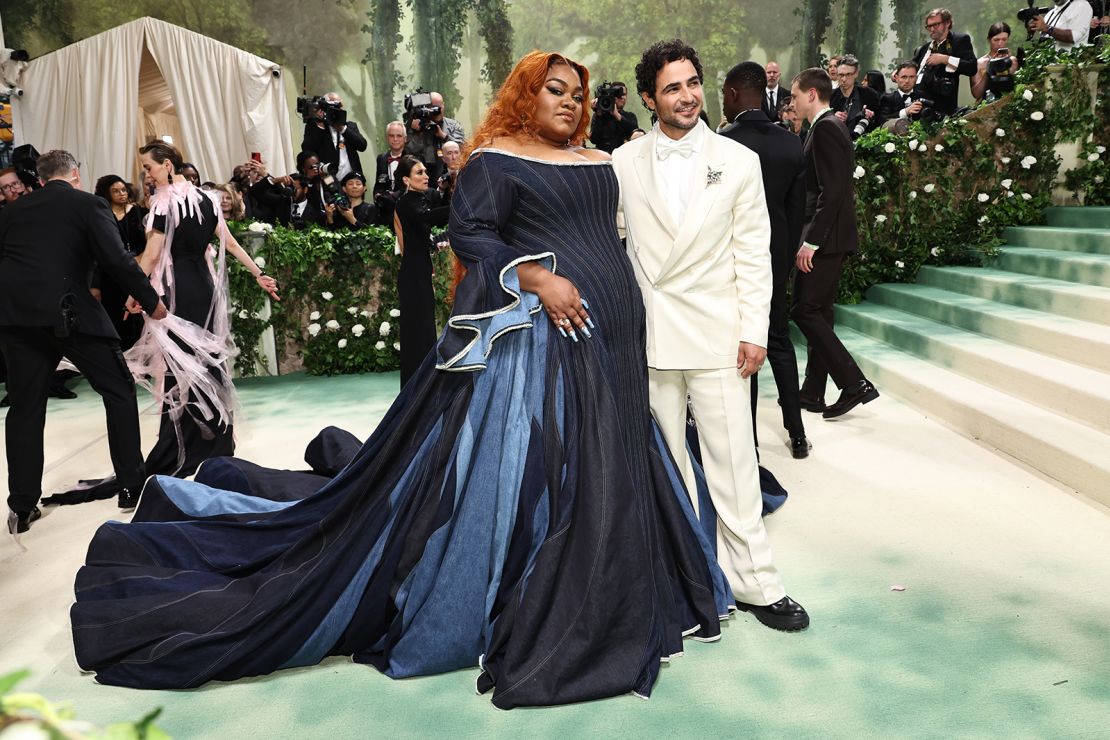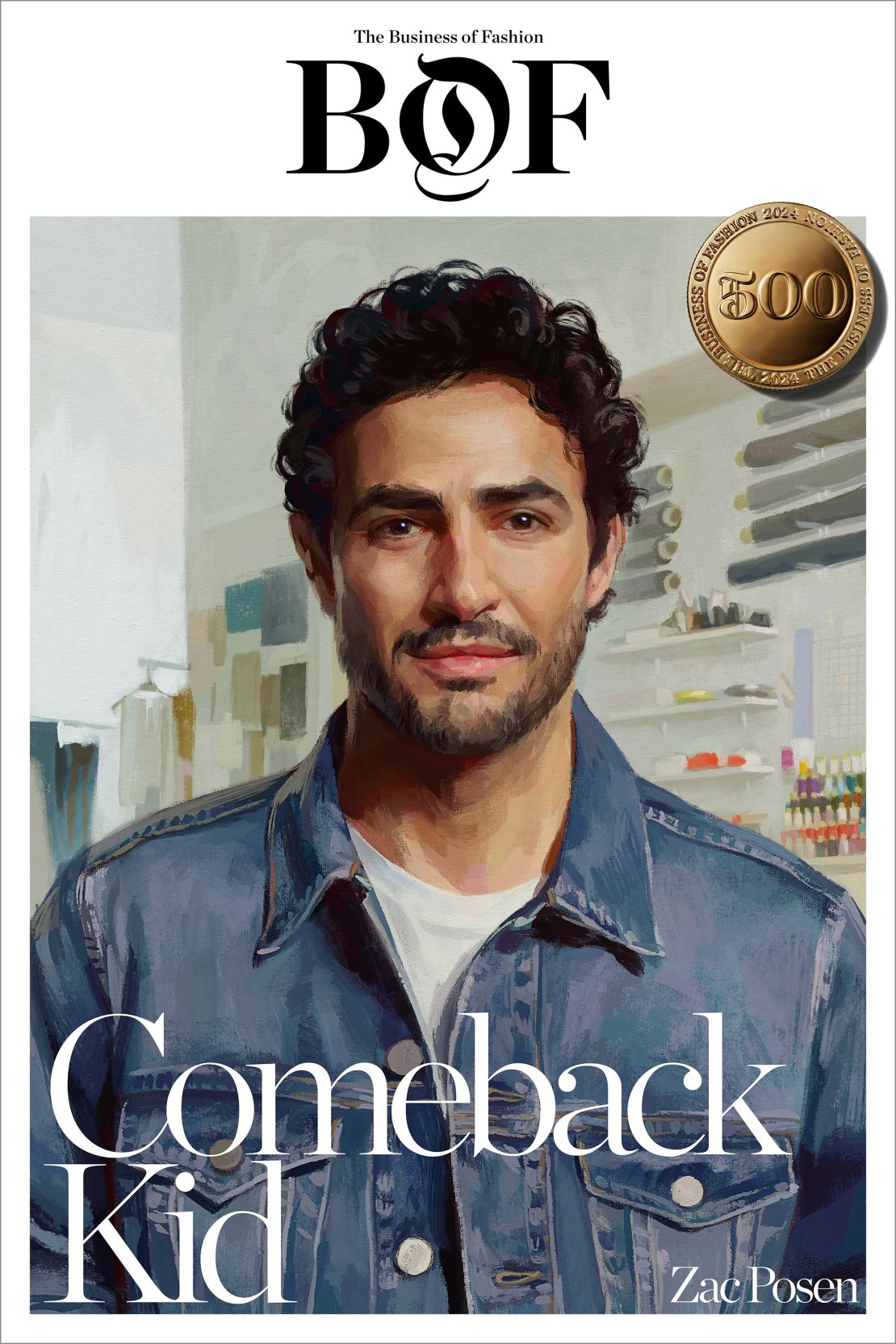Editor’s Note: This article was originally published by The Business of Fashion, an editorial partner of CNN Style.
Zac Posen points, emphatically, to a wall of blue — or rather a section of the wall filled with various swatches of navy and indigo, each imprinted with Gap’s narrow serif font logo on top.
Posen, clad in khakis, combat boots and a white shirt with a small bunny pin on its pocket, has a bounce in his step as he paces along the wall. There’s the Gap blue and the Old Navy blue. “And that’s the Gap corporate blue,” he says, referring to a rectangle in a slightly dimmer hue than the other blues.
Posen is facilitating an “evolution” of Gap Inc.’s many logos, he says, one of myriad little but consequential details of how people may perceive the company that he has pored over since joining in February. Words flow out of his grinning mouth a mile a minute. All of his blues are illuminated by a sinking afternoon sun, filtering through the windows of his corner office from across the San Francisco Bay, its own swath of teal and turquoise.
It’s in front of this view that Posen, a native New Yorker, has been for the last seven months plotting the creative future of Gap Inc. and its four brands — Gap, Old Navy, Banana Republic and Athleta — under new chief executive Richard Dickson, fueled by iced coffee and Tic Tac mints, which Posen consumed incessantly over the course of our hour-long chat.
Re-energizing Gap Inc. is a task of colossal proportions. The sheer size of the retailer is formidable enough, but the real challenge is reversing its decades-long stagnation. The San Francisco-based company was founded in 1969 by Donald and Doris Fisher as a denim and record store. Under the stewardship of merchandising maestro Mickey Drexler, Gap hit its cultural peak in the 1990s, at the height of American mall culture, as the go-to option for the dominant American office uniform of the time: khakis and an Oxford shirt. In that decade, Gap sales grew at a compounded average annual rate of about 22%. In 2000, its market capitalization was north of $40 billion — five times that of today.
But as the top line continued to expand in the aughts, growth slowed down. Drexler exited the company in 2002. Perennial discounting became a bad habit just as foreign newcomers H&M, Zara and Uniqlo disrupted the American fashion landscape. For more than 20 years, sales at Gap Inc. stalled; last year, it generated $14.9 billion in net sales, down from $16.6 billion in 2018.

Since 2014, the Gap brand has nearly halved its presence in North America, going from 968 stores in the market to 472 as of February. It makes up about 20% of overall Gap Inc. revenue, while Old Navy accounts for more than half. Expansion efforts into Asia during the 2010s were effectively reversed last year, when the company announced the sale of its Gap Greater China business, which is now franchised. An effort under Dickson’s predecessor, Sonia Syngal, to focus on Old Navy and Athleta, which for years outperformed Gap and Banana Republic, failed to kick start a new cycle of growth; Old Navy and Athleta have suffered in recent years due to a weak product offering and muddled brand identities.
In recent quarters, Gap Inc. has made progress under CEO Dickson, who came to the company from toymaker Mattel last summer after orchestrating the blockbuster comeback of Barbie, Mattel’s iconic but long-beleaguered doll — a result investors would love to see at Gap.
It was Dickson who handpicked Posen to be his creative right hand late last year, and so far, the two of them have managed to inject some cultural energy into the Gap brand, tapping Gen-Z-friendly pop stars Tyla and Troye Sivan for campaigns and signing off on a slew of buzzy collaborations with the likes of MadHappy and Dôen. Three months into his job, Posen worked his magic of wooing Hollywood, designing a dashing denim number for Da’vine Joy Randolph’s appearance at the Met Gala from Gap’s own atelier. (He escorted her on the red carpet in a Banana Republic suit of his own.) Another piece designed by Posen, a white corseted shirt dress, went viral, selling out on Gap’s website within hours, after Anne Hathaway wore it at a Bulgari event last summer.
“Understanding the opportunity of Gap’s reach was really powerful to me,” Posen says.
Shares in Gap Inc. have increased more than 100% in value in the past year. But both Dickson and Posen would agree that the project of revitalizing the company is just getting started.
The wall of blue in Posen’s office speaks to the nature of his challenge: It’s a massive undertaking and yet, when it comes to rebooting a brand, no detail is too minute. Most of his accomplishments so far have been more tactical interventions: one-off pieces for a capsule, a store makeover in New York’s SoHo, the Met Gala gown. But to effect change at the scale of a $15 billion company, Gap’s new leadership is going to have to re-invigorate every fundamental component of the business, from its product offering and store presentation to its internal culture — which insiders describe as resistant to change — and, ultimately, how consumers out in the real world think about a company that until lately they haven’t thought about at all.
For Posen, the stakes are doubly high. If he pulls it off, his work at Gap Inc. won’t just be redemption for the American retailer; it will be a vindication of his own talent and stature in the fashion industry, which ordained him as a prodigy 20 years ago only to see him lose control of his namesake label and fall off the map.
“When I think of Zac, Isaac Mizrahi keeps coming to mind,” says Gabriella Santaniello, a retail analyst, pointing to the American designer who, like Posen, garnered massive critical acclaim through his eponymous label in the early 1990s (Posen launched his label a decade later). But the brand struggled financially and was eventually sold to licensing firms Xcel Brands and then WHP Global. Today, Mizrahi remains the designer of the label, which is sold through department stores and QVC.
Before Gap, Posen was on track for a similar trajectory to Mizrahi’s. Now, Posen’s prospects — like Gap’s — are looking brighter, his chances of a comeback tightly bound to the fortunes of his new employer.
The road to Gap by Zac
Born and raised in New York City, Posen became a wunderkind American designer in the early 2000s and the story of his ascent is nothing short of a fashion fairytale.
As a student at the elite private school Saint Ann’s, his classmates included Lola Schnabel, the daughter of painter Julian Schnabel, and writer, director and actress Lena Dunham, whom Posen used to babysit. As a teenager, Posen had a flair for fashion; before college, he had already interned for Nicole Miller and the Metropolitan Museum of Art.
In London, where he was a fashion student at the prestigious Central Saint Martins, one of his dresses was spotted by ‘90s supermodel Naomi Campbell, who was so impressed with it that she tracked down the designer and paid a visit to his basement apartment in Bloomsbury.
Months later, at a party, another dress of his — a pink fluttery bias-cut frock — caught the attention of a New York Times reporter. The resulting article, published in February of 2001, was titled, “A Star Is Born.” He was only 20 years old.
But if Posen’s rise was a fairytale, his fall from grace was Brothers Grimm. While Posen’s gowns were a fixture of the American red carpet for more than a decade, his label struggled to find a commercial foothold, and Posen’s personal profile — he has attended nearly every Met Gala since 2003 — eventually outshone the clothes he made.

In 2019, his eponymous brand was shuttered by majority owner Yucaipa, the private equity firm fronted by Ron Burkle, who was introduced to Posen by Sean Combs, the rapper known as Diddy. The following year, its intellectual property, including the name Zac Posen, was sold to licensing firm Centric Brands.
“It was this moment of watching your own funeral,” Posen says. Today, every Zac Posen dress on the market — some still available at Bloomingdale’s and Neiman Marcus — has no affiliation with Posen himself.
But Gap by Zac Posen — that’s still unchartered territory. And in recent months, in his office overlooking the San Francisco Bay, Zac Posen’s next chapter has been taking shape.
Of course, it’s not the first time Gap has pegged its future on a fashionable name with an impressive resume. In 2007, at the onset of its slowdown, the company poached then-Paco Rabanne artistic director Patrick Robinson to be head designer for the Gap brand. But Robinson’s high-fashion touch never resonated with Gap customers. Then, there was the Yeezy debacle: Gap had announced the tie-up with the rapper and designer formerly known as Kanye West in 2020 with much fanfare, projecting the venture would generate $1 billion within five years. Instead, it took two years for Yeezy Gap to roll out to stores and just months later, Ye terminated his agreement with Gap, citing breach of contract .
When Gap Inc. announced it had tapped Posen to lead all things creative in February, there was a sense of puzzlement amongst fashion insiders.
“You think of Gap as a very casual brand that sells in a million stores in the US,” says Julie Gilhart, one of Posen’s first stockists for his namesake brand more than two decades ago when she was the fashion director at Barneys. Posen was known for eveningwear — big, dramatic gowns with fishtails and tulle. And since his own label was sold to a licensing firm four years ago, he has not held another high-profile role in the industry.
“When you do word association with Zac Posen, ‘casual’ doesn’t come up,” Gilhart adds. “It was an unusual choice. No one would’ve expected it.”
Posen is perhaps just as much of a long shot as his predecessors. But the narrative symmetry between Posen the former prodigy who lost his way and Gap the once-iconic, now-ailing behemoth is undeniable — and for Dickson, a major selling point.
“The dialogue around Zac’s journey and our brands’ journey is very integrated,” Dickson says. “It creates thick skin and you can tolerate the challenges of turning a business around.”
Corporate chemistry
When Posen received the phone call from Dickson last autumn, he was still in a prolonged state of recovery. After his company dissolved, he had time to relax and work on personal projects. He went to see shows at the theatre. He began taking on private commissions again, including gowns and bridalwear, starting with a dress for Bernadette Peters, one of his earliest clients from his student days.
“I was in an incredibly reflective and valuable moment in my life, personally and professionally that I hold very sacred,” Posen says.
When the pandemic hit, he was happy to stay home to cook and garden. He was commissioned by the New York City Ballet, whose former-principal dancer Harrison Ball is Posen’s now fiancé́, and then by director Ryan Murphy to costume a part of the TV show “Feud: Capote vs. the Swans.”
Posen was also disillusioned with fashion and fashion was disillusioned with him. After all, the kingdom of fashion that had welcomed him with an open embrace eventually spat him out. He toyed with going into cinema or becoming a Disney Imagineer. Then he met Dickson.
It was a warm afternoon in late October. The two had spoken on the phone and agreed to meet at Balthazar, a popular bistro in New York’s SoHo neighborhood. Posen felt familiar eyes on him as he walked into the bustling restaurant. “I was like, ‘Oh, no, we’re gonna get clocked immediately,’” he says.
Dickson had been chief executive of Gap Inc. for just shy of four months. He was taking on the white whale of American retail, one of the largest specialty fashion chains in North America in terms of footprint (behind only TJ Maxx and its sister stores), which had seen a revolving door of CEOs in the past decade, each failing to execute on their respective visions to turn the business around.
This time around, when searching for the right creative partners, Dickson cast a wide net. When he met Posen, he was in conversation with several other candidates, including creatives outside of fashion.
Posen’s first impression of Dickson was that he was an elegant-looking man, a crossover between a rockstar and a Kennedy. The rest, he says, “was kismet.”
The two instantly connected over what they see as the power of creative expression, of product and communication, and a mutual belief that a brand can have a bigger purpose.

“The lightbulb moment for Zac was that these brands are canvases for creativity on such a massive scale,” says Dickson. Like Posen, he speaks of Gap and the work they’re doing together — the work of, ultimately, selling clothes — in grandiose terms, alluding to the idea that their company could perhaps change the world.
“A brand is about bringing together people,” Posen says. “If you can leave the world an ounce of a better place, that’s what it’s about.”
But alongside the big thinking, Dickson was drawn to Posen’s humility. “The recognition that he had experienced the peaks, the pits and the process in between,” he adds. “Now think about Gap. Gap peaked and Gap (tumbled). All the trials and tribulations these brands had gone through.”
The affinity was reciprocal. After their chat, Posen was electrified, he recalls. His 43rd birthday party had been that same night, on the Lower East Side. “Everyone was like, what’s going on?” he recalls. “People could physically just see that I was excited about something.”
Two weeks later, Posen flew to San Francisco to meet Gap Inc.’s board of directors, including Robert and William Fisher, sons of the company’s founders. He snuck out after hours from an elevator shaft the building to keep the interview a secret, and when he returned three months later, he had already been handed the creative reins. “I accepted the job and didn’t really know what to expect,” he says.
But Dickson was the “business partner that I had only ever dreamt of meeting in my life,” Posen adds. And together, they set out to find Gap Inc.’s purpose again.
Early innings
Traveling back and forth from New York with his fiancé́, the designer got to work. Together with the rest of the company’s senior leadership team, which includes Gap CEO Mark Breitbard, Old Navy CEO Horacio Barbeito and Athleta CEO Chris Blakeslee, Posen joined the effort to sharpen the identities of the four brands in Gap Inc’s portfolio.
They started by redefining the positioning of each brand: Gap as a pop culture brand. Old Navy as an affordable style authority for America. Banana Republic as a lifestyle brand for the modern explorer. And Athleta, a performance brand amplifying the “Power of She,” the name of its athlete ambassador program with its own philanthropy arm addressing female empowerment.
Posen then set about trying to bring these repolished identities to life. His team commissioned a flurry of creative agencies, including Collins Group, which is spearheading the Old Navy rebrand that will come to life later this year. He made a meticulous marketing schedule, overseeing every activation across the portfolio, from opportunities around national holidays to store openings. He lent his creative eye to Banana Republic’s redesign of its SoHo flagship in June, and tapped longtime American Vogue editor Tonne Goodman to style its fall collection.

But most impactful has been his hand in engineering major cultural moments for Gap, from the dramatic draped denim gown he designed for Da’Vine Joy Randolph’s Met Gala appearance to the brand’s recent Troye Sivan campaign promoting its line of baggy jeans, which put a modern twist on the dancing ads that helped made Gap buzzy in the ‘90s and ‘00s.
Last month, Old Navy provided the T-shirts worn at a voter registration rally hosted by the Council of Fashion Designers of America and Vogue during New York Fashion Week.
There was also the white corseted shirt dress Posen created for Hathaway, which she wore at a Bulgari event in Rome a day after the Met Gala. Three months later, the dress made headlines once again when it was photographed on New York it-girl Julia Fox, who paired it with a lime green hat.
There’s no doubt that Posen has been instrumental in creating some big moments for Gap Inc. this year. Whether he will be able to improve Gap Inc.’s product assortment — particularly at Old Navy, for which he serves as chief creative officer — remains to be seen. A full reflection of Posen’s influence on products won’t be seen until the holiday season, but there are certain pieces so far for which he can take particular credit: a rainbow striped T-shirt in Old Navy’s recent vintage-inspired capsule collection, a dramatic version of barrel-legged jeans for Gap.
“This is really the beginning and I feel so premature with all of this, but we are in the cultural conversation and the brand is being spoken about,” Posen says. “On top of that, we are slowly but surely bringing the product back to relevance.”
There are early signs of commercial success: So far this year, Gap Inc. has reported two consecutive quarters of year-over-year sales growth. Of its four brands, only Athleta saw a significant sales decline in its second quarter ending Aug. 3. In terms of cultural reach, Gap Inc. seems to be making inroads: for example, Gap saw a 73% increase year-on-year in influencer mentions in the two months following the launch of its collaboration with Dôen in May, according to influencer marketing platform Traacker.
Gap’s shopping experience has improved, analysts say, pointing to more focused merchandising and better styling in stores and online alike. Discounting is also down, they note.
But some are still skeptical of Posen’s impact.
“To me, Zac Posen at Gap smells a little bit like Kanye 2.0,” says Lee Peterson, a retail veteran who worked for Gap’s competitor, The Limited, during its heyday in the 1990s. “He’s like a rockstar who had a bunch of big hits, but he hasn’t had a big hit in a long time.”
Posen says his success will be measured in “relevance and revenue” — the complete outcome of which will be greater than the sum of its parts.
“What’s the product and what’s the storytelling? How do we sell it? How do we become part of the conversation and grow the company and attract new customers and bring back old friends?” he says, listing his full roster of responsibilities at Gap Inc. in one breath. And then a pause. “It’s a marathon, not a sprint.”
Editor’s Note: This article was originally published by The Business of Fashion, an editorial partner of CNN Style.


